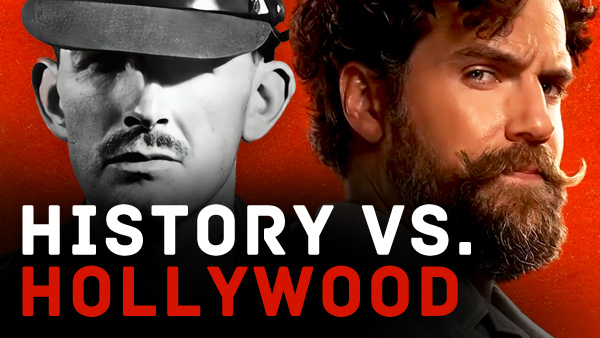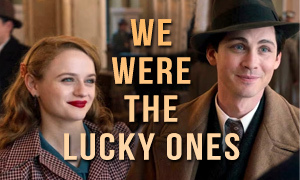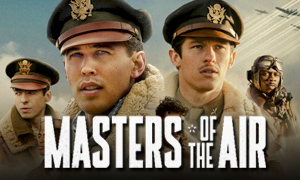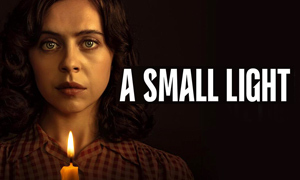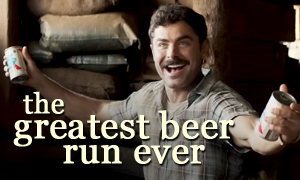The Monuments Men: History vs. Hollywood
based on the book 'The Monuments Men' by Robert M. Edsel
| REEL FACE: | REAL FACE: |
George Clooney
Born: May 6, 1961 Birthplace: Lexington, Kentucky, USA | George Leslie Stout
Born: October 5, 1897 Birthplace: Winterset, Iowa, USA Death: July 1, 1978, Santa Clara, California, USA Skill: Art Conservation |
Matt Damon
Born: October 8, 1970 Birthplace: Boston, Massachusetts, USA | James Rorimer
Born: September 7, 1905 Birthplace: Cleveland, Ohio, USA Death: May 11, 1966, New York City, New York, USA (heart attack) Skill: Museum Curator |
Cate Blanchett
Born: May 14, 1969 Birthplace: Melbourne, Victoria, Australia | Rose Valland
Born: November 1, 1898 Birthplace: Saint-Étienne-de-Saint-Geoirs, Isère, France Death: September 18, 1980, Ris-Orangis, France Skill: Art Historian, Spied on Nazis During Looting of France |
Bill Murray
Born: September 21, 1950 Birthplace: Wilmette, Illinois, USA | Robert Posey
Born: April 5, 1904 Birthplace: Alabama, USA Death: April 18, 1977, White Plains, New York, USA Skill: Architect |
John Goodman
Born: June 20, 1952 Birthplace: St. Louis, Missouri, USA | Walker Hancock
Born: June 28, 1901 Birthplace: St. Louis, Missouri, USA Death: December 30, 1998, Gloucester, Massachusetts, USA Skill: Sculptor |
Bob Balaban
Born: August 16, 1945 Birthplace: Chicago, Illinois, USA | Lincoln Kirstein
Born: May 4, 1907 Birthplace: Rochester, New York, USA Death: January 5, 1996, Manhattan, New York, USA (natural causes) Skill: Art Enthusiast |
Hugh Bonneville
Born: November 10, 1963 Birthplace: London, England, UK | Ronald Balfour
Born: 1904 Birthplace: Hampshire, England, UK Death: March 10, 1945, Clèves, Germany (killed by a shell while removing an altarpiece from a damaged church) Skill: Art Historian |
Dimitri Leonidas
Born: November 14, 1987 Birthplace: Brent, London, England, UK | Harry Ettlinger
Born: January 28, 1926 Birthplace: Karlsruhe, Germany Skill: Translator |
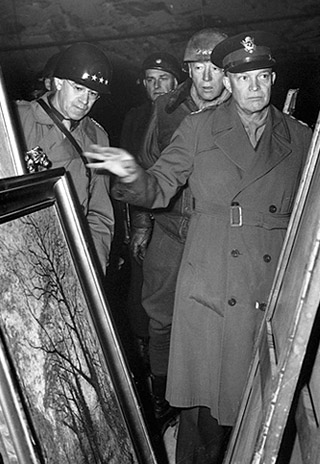
Generals Omar Bradley (left), George S. Patton, and Dwight D. Eisenhower (right) inspect art stored in Merkers salt mines in central Germany on April 12, 1945.How many total "Monuments Men" were there?

Generals Omar Bradley (left), George S. Patton, and Dwight D. Eisenhower (right) inspect art stored in Merkers salt mines in central Germany on April 12, 1945.
Though the movie keeps its focus on an Allied platoon of seven, The Monuments Men true story reveals that they were actually made up of many more individuals, eventually growing to a group of 350 or so men and women from thirteen nations. They were assigned to an Allied unit known as the MFAA (Monuments, Fine Arts, and Archives) program that was tasked by President Franklin D. Roosevelt, with the support of General Dwight D. Eisenhower (pictured). As in the movie, the group was comprised of art historians, curators, museum directors, artists, architects and educators. Many of them had also been military reservists. -The Monuments Men book
Was the only duty of the Monuments Men to recover and protect looted artworks?
No. In addition to recovering looted art and ensuring its safe return, when possible, to its rightful owners, the members of the MFAA (Monuments, Fine Arts, and Archives) program also protected vulnerable museums and churches, and worked with other military units and officials to dissuade Allied bombers from destroying targets of significant cultural importance. -HuffingtonPost.com
Was the Monuments, Fine Arts, and Archives program the idea of George Stout?
Yes, but in a more roundabout way than in the movie. Though George Clooney's Frank Stokes character's real-life counterpart, George Stout, was instrumental in the creation of the real Monuments Men (the book calls the MFAA his "brain child"), his influence wasn't as direct as the movie implies. In conjunction with his colleagues at Harvard, Stout was an invaluable influence on the creation of the American Commission for the Protection and Salvage of Artistic and Historic Monuments in War Areas, later known as the Roberts Commission. It was the Roberts Commission that created the MFAA program. George Stout was recruited as one of the unit's first members and he was one of the first Monuments Men to go ashore at Normandy. He was later appointed Lieutenant Commander of the MFAA. In the second half of 1945, Stout headed for Japan where he served as the Chief of the Arts and Monuments Division, headquartered in Tokyo. There, he carried on his role as a Monuments Man.
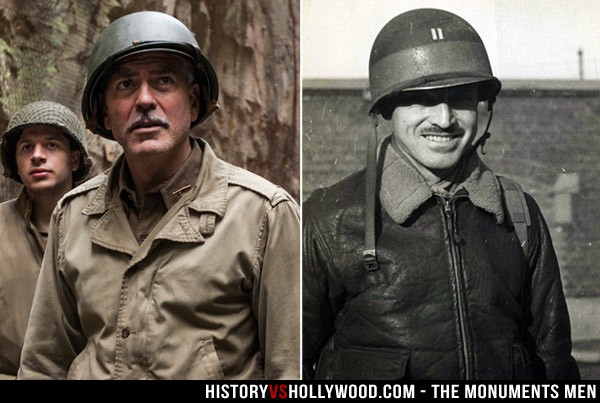
The Monuments Men director/actor George Clooney (left) in the 2014 movie and his real-life counterpart, George Stout, in Europe in the mid-1940s.
Did the Monuments Men really have to go through Basic Training?
Yes. Many of them were already reservists, but others, who had no military experience, did go through Basic Training. That training often took place in England prior to entering the field.
Did the real Monuments Men ever work together in a group?
No. Unlike the film, "...the (Monuments Men) never worked together in a group," says historian Lynn Nicholas, author of the first scholarly examination of the story, The Rape of Europa, published in 1994. -USAToday.com
Was Rose Valland really hesitant to confide the details of Nazi looting to Lt. James Rorimer?
Yes, like in the movie, it took the real Claire Simone, whose name is actually Rose Valland, some time to confide the details of the Nazi looting to Lt. James Rorimer, the real-life James Granger (Matt Damon in the movie). She was weary about who to trust and feared that the pieces would be stolen by whoever she told. Her knowledge pertained specifically to the locations that the looted objects were being shipped to. Valland, an employee of the Jeu de Paume Museum in Paris, had secretly recorded the movements of the stolen objects that the Nazis had plundered in France. The Nazis were using the museum where she worked as the headquarters for the ERR (Einsatzstab Reichsleiter Rosenberg), a special Nazi task force that engaged in the plunder of cultural valuables in occupied countries. The Nazis had allowed Rose to continue her work at the museum. Unbeknownst to the Nazis, she understood German and had listened in on their conversations. -MonumentsMen.com
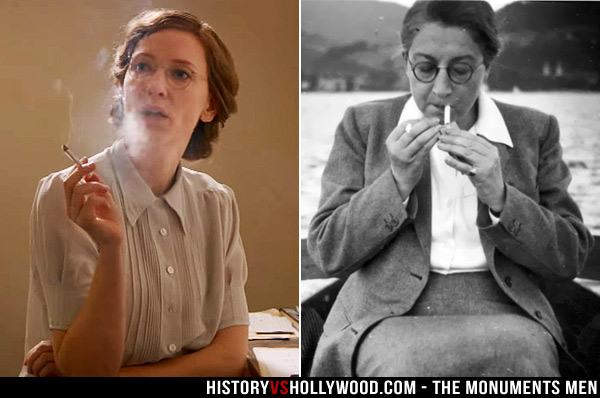
Actress Cate Blanchett (left) channels the real Rose Valland (right), who was the overseer of the Jeu de Paume museum in Paris.
Did the men really learn key information from a chatty German dentist?
Yes. In researching The Monuments Men true story, we discovered that by the end of March 1949, Robert Posey (Bill Murray in the movie) had developed a severe toothache. With the nearest army dentist being a hundred miles away in France, he and Lincoln Kirstein (portrayed by Bob Balaban) tracked down a German dentist. The talkative dentist ended up telling them about his son-in-law, an art scholar who knew France well and was there during the occupation. He then took the men to meet his son-in-law, who to their surprise ended up being a former SS officer who knew Hermann Göring, in addition to the locations of a significant amount of stolen art (including the location of Göring's collection). He also knew which of the treasures had been distributed to German museums and which art dealers in Berlin were actively trading the looted works.
Unlike the movie, the dentist's son-in-law did not have stolen art hanging in his home. The Monuments Men book states that "the walls were lined with photographs of the Eiffel Tower, Notre Dame, Versailles, and other famous Parisian landmarks." Despite trying to tell the men that he viewed the Nazis as "complete frauds" and only carried out his duties as an SS officer for the sake of protecting the art, Robert Posey and Lincoln Kirstein later discovered that, like in the movie, they had been speaking to Hermann Göring's corrupt Kunstschutz official who had been one of the key figures in the infamous looting operation at the Jeu de Paume, the museum in Paris where Rose Valland worked.
How much artwork did Nazi leaders take for themselves?
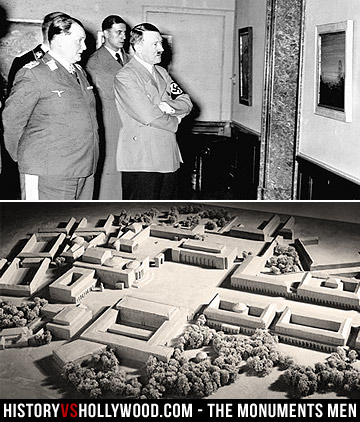
TOP: Nazi Party leaders Hermann Göring and Adolf Hitler admire a painting. BOTTOM: A 1940s Nazi model of the city of Linz, Austria that displays the planned Führermuseum.
Did Hitler really order that the art be destroyed should he die?
Yes. Through the issuance of the 1945 Nero Decree, officially titled the "Demolitions on Reich Territory Decree," Nazi leader Adolf Hitler ordered that if he died or Germany was about to lose the war, then the nearly 5 million pieces of stolen art were to be destroyed, along with factories, supply depots, transportation and communication facilities - basically anything of value that the Allies could utilize. If he lived and Germany won the war, he planned to showcase much of the art in the unbuilt Führermuseum that he envisioned for his hometown of Linz, Austria (in the movie Hitler stares at a model of this monument to himself). The Nero Decree was named after Emperor Nero, who was blamed for the fire that destroyed most of Rome in the year 64 AD. -Variety.com
Did Hitler's order that the art be destroyed ever go into effect?
No. Despite the two criteria Hitler set in the Nero Decree having been met (his death and Germany on the verge of losing the war), the decree was never actually implemented. Albert Speer, Hitler's Minister of Armaments, was given the order, but he had become disillusioned with Hitler toward the end of the war and persuaded Nazi generals to ignore the directive, a secret that he kept from Hitler. In the face of defeat, Speer believed that if things such as factories, bridges and communication lines were still in place, it would be much easier for Germany to rebuild after the war. Hitler on the other hand believed that Allied forces would plunder Germany. -Yahoo Movies
Did any of the Monuments Men actually die?
Yes, but not quite as romantically as they do in The Monuments Men movie. In the film, Monuments Man Donald Jeffries (Hugh Bonneville) bravely sacrifices himself in a failed effort to save Michelangelo's Madonna of Bruges. In real life, this did not happen. However, two Monuments Men did perish in the war. Ronald Balfour, 41, who is in fact the real-life counterpart of actor Hugh Bonneville's character Donald Jeffries, died from a shell burst while trying to move parts of an historic church's medieval altarpiece to safety (not while protecting the Madonna). The other was an American architect named Walter Huchthausen, who was shot in April 1945 near Aachen, Germany. In the movie, the fictional French character of Jean Claude Clermont (Jean Dujardin) is shot and later dies. -TheGuardian.com
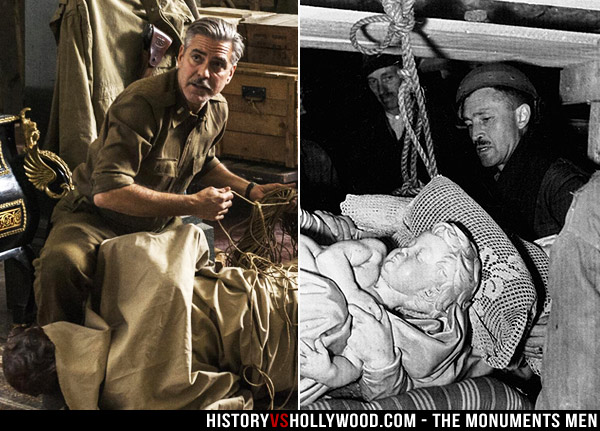
Monuments Man George Stout (right) works to secure Michelangelo's Bruges Madonna for removal from the salt mine in Altaussee, Austria on July 10, 1945. George Clooney (left) secures a sculpture in the movie.
How many times was the Mona Lisa moved in an effort to protect it?
During the war, Leonardo da Vinci's Mona Lisa was moved six times before she was returned to the Louvre. The painting was certainly an item that the Germans would have loved to have gotten their hands on. The Nazi's had created "shopping lists" of items that were earmarked for priority "removal" and transport back to Germany. Museum officials, along with the help of the Monuments Men, often went to great lengths to keep priceless works of art out of Nazi hands. -Journey of the Monuments Men
Did James Rorimer really step on a land mine like Matt Damon's character in the movie?
No. In a comedic moment of the movie, Matt Damon's character steps on a land mine, to which George Clooney's Frank Stokes replies, "Why did you do something like that?" The comment is then repeated by John Goodman's character, Walter Garfield. In relation to the real James Rorimer, Robert Edsel's Monuments Men book does convey Rorimer's concerns with mines and minefields, not only mentioning the dangers but also Rorimer hearing the sounds of exploding mines, minesweepers and signs that warned of land mines. However, at no point does James Rorimer accidentally step on a mine. Mines were common in the war and presented an ever present danger when searching for and attempting to recover and safeguard artifacts.
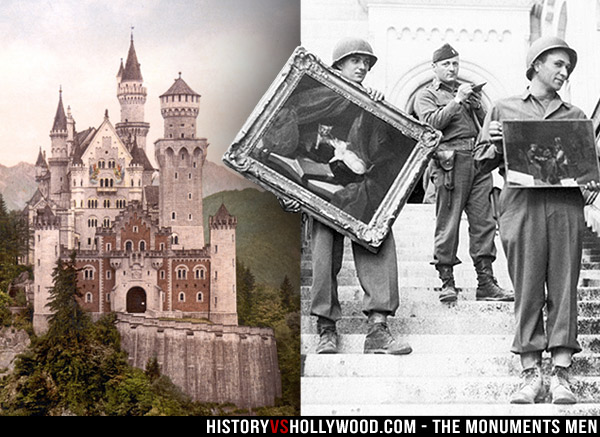
James Rorimer (right center) supervises American GIs carrying paintings down the steps of Neuschwanstein Castle (pictured left) in Germany's Bavarian Alps in May of 1945. The palace, built by King Ludwig II of Bavaria and completed in 1892, was the inspiration for Disneyland's Sleeping Beauty Castle.
Did they really find gold fillings like in the movie?
Yes. The book describes a soldier at Merkers salt mine showing Generals Eisenhower, Patton and Bradley a bag of gold fillings that had been pulled from the teeth of Holocaust victims. Other reports describe the discovery in more detail, citing chests full of gold fillings, similar to what is seen in the movie. -MonumentsMen.com
Did they really discover a stash of gold bullion?
Yes, and as we explored the true story, we learned that the press focused more on the gold than the recovered art. -RollingStone.com
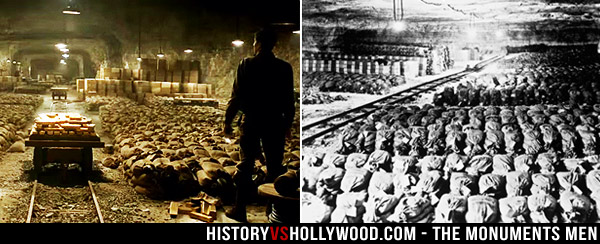
The Monuments Men discover Nazi gold bullion in the movie (left). In real life, more than 100 tons of Reichsbank gold was discovered in the salt mine at Merkers (right), April 15, 1945.
How many art and artifacts were looted?
During our investigation into The Monuments Men true story, we came across estimates as high as 20 million. However, in general the estimates vary widely, with many placing the number of looted art and artifacts far lower, at somewhere between five and six million. Much of it was taken by Hitler and his Nazi lieutenants for themselves and Germany. The MFAA managed to recover and return around five million pieces to their owners or their countries of origin, since many belonged to Jews who had died in the Holocaust. -USAToday.com
Is some of the art stolen by the Nazis still missing?
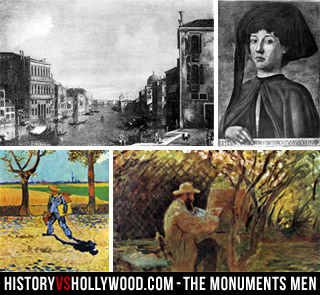
Plundered masterpieces still missing include (clockwise from top left): Bernardo Bellotto's "View of the Grand Canal in Venice," Sandro Botticelli's "Portrait of a Man," Claude Monet's "Manet painting in Monet's Garden" and Van Gogh's "Vincent on his way to work."
In as recently as November 2013, a stash of art consisting of over 1,200 works was discovered in the Munich apartment of an art dealer who was in business during that time. The story made headlines around the world and it is believed that some of the art might have passed through the Monuments Men's hands. It was often difficult to be sure that the art was being returned to the proper individuals. -SFGate.com
Does George Clooney's real-life father appear in the movie?
Yes. Nick Clooney, the father of Monuments Men director and actor George Clooney, appears in the movie during a 1970s epilogue, portraying an aged Frank Stokes (George Clooney). -Variety.com
Were any of the real Monuments Men alive in 2014 at the time of the movie's release?
Yes. The real-life counterpart to the movie's Pvt. Sam Epstein, a German-Jewish teen who is the driver and translator for the men in the film, is still living. In real life, his name is Harry Ettlinger. He was 19 when he volunteered to join the Monuments Men after hearing that a small group was looking for someone who could read and write German. Ettlinger's family had left Germany and fled to New York in 1938. Of the 350 or so total Monuments Men, Harry Ettlinger is one of six who are still living. -NYTimes.com
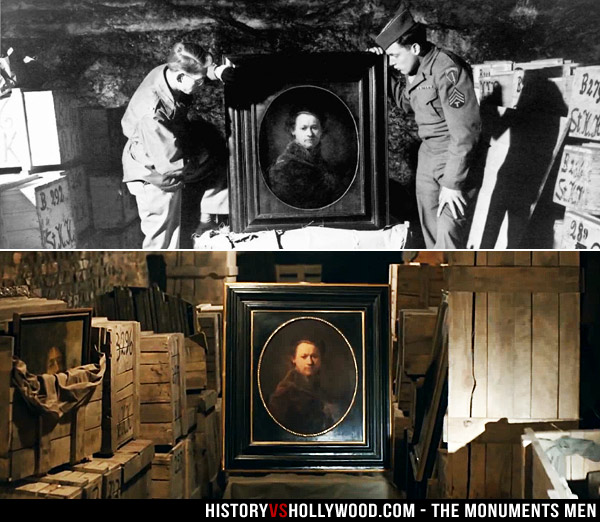
TOP: Monuments Men commander Lt. Dale Ford and then 19-year-old Monuments Man Harry Ettlinger look over an original self-portrait by Rembrandt hidden by the Nazis in the Heilbronn-Kochendorf salt mines. BOTTOM: The discovery of the painting is depicted in the movie.
Were all of the descendants of the real Monuments Men happy with the film?
No. The descendants of Ronald Balfour, a British medieval historian and one of two Monuments Men who perished in the war, were upset that the film didn't more closely represent Ronald. Actor Hugh Bonneville's character, Donald Jeffries, has been linked to Ronald. Like Ronald, the character is an English historian serving with the MFAA who holds the rank of major. However, one of Ronald's nieces, Polly Hutchison, says that the actor is "so different." She says the family was astounded when they heard that Hugh Bonneville was going to portray the character they hoped would be her Uncle Ronald. It should be noted that the official Monuments Men movie website does in fact pair Hugh Bonneville's character with Ronald Balfour, in addition to other online sources that have confirmed the correlation. -TheGuardian.com
Are there any modern-day "Monuments Men"?
Yes. The desire to protect art during times of war was not just a concern during World War II. Evidence of similar efforts still exist today, though not on the same level as during WWII. For example, Major Corine Wegener (retired) is a modern-day "Monuments Woman" who served in Iraq. A curator at the Minneapolis Institute of Arts (MIA) and a member of the Army Reserves, Wegener was called into service in 2003, shortly after the start of the Iraq War. Her job was to work with the staff of the National Museum of Iraq in Baghdad in response to the substantial looting that took place. After retiring from the military in 2006, Wegener created the US Committee of the Blue Shield, which is the cultural equivalent of the Red Cross. She went to Haiti after the 2010 earthquake, and in 2012 Wegener took a job with the Smithsonian to lead efforts to protect cultural heritage around the world. -Minnesota Public Radio
What efforts are being made today to ensure that art is protected during times of war?
In addition to people like former museum curator and retired Army major Corine Wegener (discussed above), increasing efforts are being made to improve military training pertaining to the protection and preservation of cultural property. However, during World War II, it was much easier to find an art expert in the ranks of the military, especially following the draft. With regard to the Iraq War, finding experts on Iraq archaeology in today's all-volunteer military is far less likely. -USAToday.com
Have any other movies been made about the Nazi plundering of art during WWII?
Yes. Director John Frankenheimer's 1964 film The Train starring Burt Lancaster tells the story of a group of Resistance fighters who must stop a train loaded with French art that is bound for Germany. It is loosely based on Rose Valland's non-fiction book Le front de l'art.
Monuments Men Interviews & Movie Trailer
Watch an interview with real Monuments Man Harry Ettlinger, who is represented by Dimitri Leonidas in the film (the young driver/translator). Also, check out The Monuments Men movie trailer.
WATCH Monuments Man Harry Ettlinger InterviewHarry Ettlinger, born in Karlsruhe,
Germany on January 28, 1926, fled to the
U.S. with his family in 1938, the day
after his Bar Mitzvah. They settled in
Newark, N.J., and six years later Harry
was drafted by the Army and returned to
Europe, where his fluency in German
allowed him to volunteer to help the
Monuments Men. In this interview, he talks
about Nazi plundering and the respectful
decision by America to return the
recovered cultural treasures to their
proper countries, including Germany. |
WATCH The Monuments Men TrailerWatch The Monuments Men movie
trailer for the film starring George
Clooney, Matt Damon, Cate Blanchett and
John Goodman. Directed by George Clooney,
the film is based on Robert M. Edsel's
similarly titled book that tells the story
of the Monuments, Fine Arts, and Archives
program that the allies carried out during
WWII to protect valuable pieces of art and
other culturally significant items from
destruction by Hitler and the Nazis. |
Link-to-Learn More:
- List of the Most Wanted Missing Works of Art
- The Monuments Men Official Book Site
- The Monuments Men Foundation for the Preservation of Art
- The Monuments Men Official Sony Pictures Movie Website

